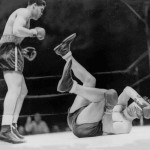Will fight live up to hype? History provides a clue
LAS VEGAS (AP) — It’s the richest fight ever, with staggering paydays and ticket prices to match. For one night, at least, boxing will be back center stage, with the world waiting to see what unfolds.
The big question is this: Can Floyd Mayweather Jr. and Manny Pacquiao deliver the fight this kind of hype deserves?
History is a mixed bag when it comes to big fights. But here are three that lived up to their hype:
ALI-FRAZIER 1: This fight was so big, Frank Sinatra got a job as a ringside photographer at Madison Square Garden.
The original Fight of the Century in 1971 featured two unbeaten heavyweights getting record purses of $2.5 million, and the rich and famous gathered at the Garden to see if Muhammad Ali could overcome his three-year exile and regain the heavyweight title from Joe Frazier. Adding to the excitement was the fact the two fighters genuinely didn’t like each other.
Ali fought well, flicking out his left jab and landing combinations. But Frazier was relentless, stalking Ali all night long, throwing vicious left hooks that caused Ali’s face to swell. In the 15th round he landed one flush, sending Ali to the canvas and cementing a decision win. The two would fight a trilogy, with Ali winning the next two fights, including the infamous “Thrilla in Manilla”
LEONARD-HEARNS: Sugar Ray Leonard had the gold medal and the smile everyone loved. Tommy Hearns was a fearsome puncher with a right hand that knocked opponents senseless. They met in their prime on Sept. 16, 1981, outdoors at Caesars Palace in a fight that will live in boxing lore.
It was a fight that had everything, including classic ebb and flow, but Hearns appeared heading to victory when he changed strategy and began boxing Leonard in the middle rounds instead of trying to knock him out. At the end of the 12th round, trainer Angelo Dundee screamed at Leonard “You’re blowing it son, you’re blowing it.”
His face swollen and his chances fading, Leonard turned puncher, landing a series of vicious punches in the 13th round to stop Hearns and give him his first loss.
“I always felt the end results are what counts,” Leonard said after.
LOUIS-SCHMELING: It was 1938, and storm clouds were gathering in Europe as Germany began pushing for world domination. Max Schmeling was touted as the perfect example of Arian superiority after having handed Joe Louis his first loss two years earlier, and from the beginning this heavyweight fight was seen as a showdown between the two most powerful countries on Earth.
Yankee Stadium was packed with 70,043 fans, and some 100 million people listened on their radios as the Brown Bomber defended his title for the fourth time. America didn’t have to wait long to celebrate as Louis completely dominated Schmeling, finally stopping him at 2 minutes and 4 seconds of the first round.
In Germany, meanwhile, the broadcast was quickly taken off the air.
Here are three fights that didn’t live up to their hype:
ALI-HOLMES: Most experts thought Muhammad Ali was done as he came back out of retirement to challenge Larry Holmes for the heavyweight title, but that didn’t stop his legions of fans from believing he could beat his former sparring partner. The fight was so big that Caesars Palace built a 30,000-seat temporary stadium in October 1980 for the first outdoor fight on the Strip.
Ali came into the ring having magically lost so much weight he was trim and seemingly fit at 217 pounds. But his jab was a shadow of what it once was and his reflexes were shot as Holmes had his way with him. Holmes was trying to save Ali from further punishment in the later rounds, and Ali’s corner finally stopped the fight after the 10th round.
Ali would fight once more, but on a sad night in the desert it was the end for The Greatest.
LOUIS-CONN 2: Their first fight in 1941 was a classic, with Billy Conn leading before trying to go for a knockout in the 13th round and being stopped by Louis. World War II meant the rematch in 1946 was four years late, though the delay did allow the fight at Yankee Stadium to be the first broadcast on national TV.
The viewing audience didn’t see much of a fight, with Louis dominating from the opening bell before finally stopping Conn in the eighth round. Conn’s performance earned him the “Flop of the Year” award voted on by members of The Associated Press.
ALI-LISTON 2: Cassius Clay had beaten Sonny Liston a year earlier to win the heavyweight title in huge upset, but now it was Muhammad Ali in the rematch. The fight was originally scheduled for Boston but Ali had emergency surgery and it was postponed. By the time it was rescheduled in May 1965 it had been moved to a junior hockey rink in Lewiston, Maine amid allegations Liston was beholden to the mob.
There would be many more allegations later, after a right hand that few saw caught Liston in the first round and he went down and was counted out. Liston said the so-called phantom punch was real but “I could have gotten up, but I didn’t hear the count.”
Copyright © The Associated Press. All rights reserved. This material may not be published, broadcast, rewritten or redistributed.


